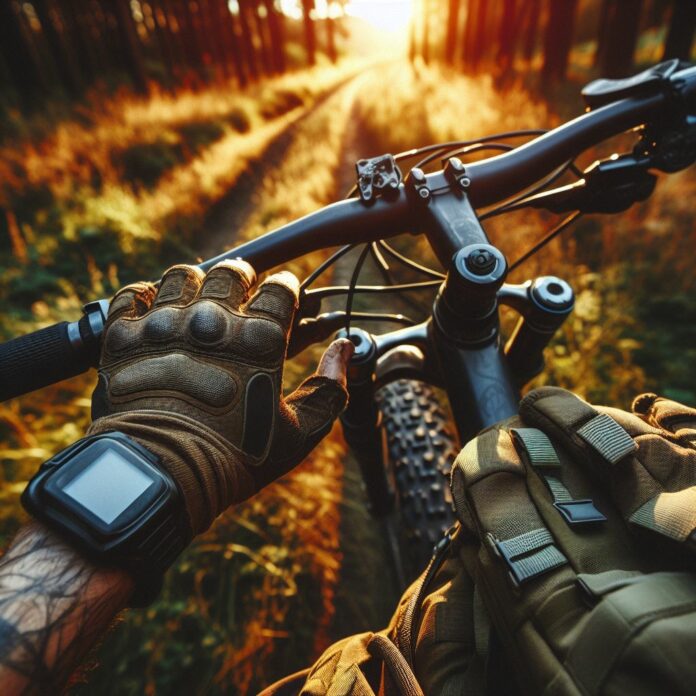Biking adventures in the wilderness offer a thrilling and immersive experience for outdoor enthusiasts. However, planning is essential to ensure a safe and enjoyable journey. This article will guide you on how to plan a biking adventure in the wilderness.
Why is planning your biking adventure important? Planning provides several benefits, including minimizing risks, ensuring you are prepared for unforeseen circumstances, and maximizing your overall experience. It allows you to make informed decisions about your route, gear, and safety measures.
Choosing the right wilderness biking destination is crucial. Researching potential locations helps you find trails that match your skill level and preferences. Evaluate terrain and difficulty levels to ensure they align with your biking abilities. Consider seasonal factors such as weather conditions and trail accessibility.
Preparing for your biking adventure involves assessing your fitness level, acquiring the right gear and equipment, and mapping out your route. Assessing your fitness level helps you determine the intensity and duration of your trip.
Acquiring the right gear, such as a suitable bike and safety equipment, ensures you are adequately equipped. Mapping out your route helps you stay on track and avoid getting lost.
Survival skills and safety tips are essential knowledge for wilderness biking. Basic wilderness first aid, navigating with a compass and map, and knowing how to handle wildlife encounters are crucial skills to ensure your safety and well-being.
Packing the right essentials for your wilderness biking trip is vital. Clothing and protective gear should be suitable for the weather conditions and offer adequate protection. Sufficient food, water, and hydration resources are necessary to sustain your energy levels. Camping and sleeping equipment provide comfort during overnight stays.
Planning for emergencies is crucial to handle unexpected situations. Creating a communication plan ensures you can reach out for help if needed. Knowing emergency shelter and fire starting techniques prepares you for unforeseen circumstances. understanding how to deal with bike breakdowns or injuries helps you stay prepared for any mishaps.
Environmental considerations and practicing Leave No Trace principles are essential in preserving the wilderness. Respecting wildlife and their habitat, minimizing your environmental impact, and properly managing waste and litter contribute to the sustainability of these pristine areas.
By following these guidelines and taking the necessary precautions, you can plan a successful and safe biking adventure in the wilderness, creating unforgettable memories while being mindful of the environment.
Why Plan Your Biking Adventure?

Benefits of Planning
The benefits of planning your wilderness biking adventure are numerous and essential for a successful and enjoyable experience:
- Enhanced Safety: Planning enables you to anticipate and prepare for potential risks and dangers, reducing the likelihood of accidents or injuries.
- Efficient Use of Time: By mapping out your route and scheduling stops, you can optimize your time and cover more ground, maximizing your adventure.
- Improved Preparedness: Planning allows you to gather the necessary gear, equipment, and supplies, ensuring you have everything you need for a safe and comfortable biking trip.
- Enhanced Enjoyment: When you plan your biking adventure, you can research and select the most scenic and rewarding routes, ensuring you have a memorable and satisfying experience.
- Reduced Stress: Knowing the terrain, difficulty levels, and seasonal factors ahead of time allows you to mentally and physically prepare, minimizing stress and uncertainty during your adventure.
Fact: According to a study conducted by the Outdoor Foundation, individuals who plan their outdoor activities in advance are more likely to engage in regular outdoor physical activity and experience improved mental well-being.
Ensuring Safety and Preparedness
Ensuring safety and preparedness is paramount when planning a biking adventure in the wilderness. Here are the essential steps to stay safe and ready:
- Check the weather forecast and plan, accordingly, making sure you have suitable clothing and gear to protect against changing conditions.
- Inspect your bike before the trip, ensuring that all components are in good working order. Regular maintenance is vital to avoid breakdowns.
- Create an emergency plan that includes communication methods and designated meeting points. Inform someone about your itinerary and estimated return time.
- Carry a first aid kit containing essentials for minor injuries and basic medical needs. Acquire knowledge of wilderness first aid to be prepared for any emergencies.
- Learn how to navigate through the wilderness using a compass and map. These skills are invaluable for staying on track and finding your way back.
- Familiarize yourself with the local wildlife and understand how to handle encounters. Respect their space and know what to do in case of dangerous situations.
- Stay hydrated by bringing an adequate supply of water and snacks for the duration of your trip. Ensure you have a way to purify water from natural sources if needed.
- Be aware of your surroundings and potential hazards such as uneven terrain, steep slopes, or wildlife habitats. Remain cautious at all times to prevent accidents.
- Leave no trace of your presence in the wilderness. Properly dispose of waste, pack out any trash, and respect the natural environment and wildlife.
By following these steps, you can guarantee your safety and preparedness for a successful biking adventure in the wilderness.
Choosing Your Wilderness Biking Destination
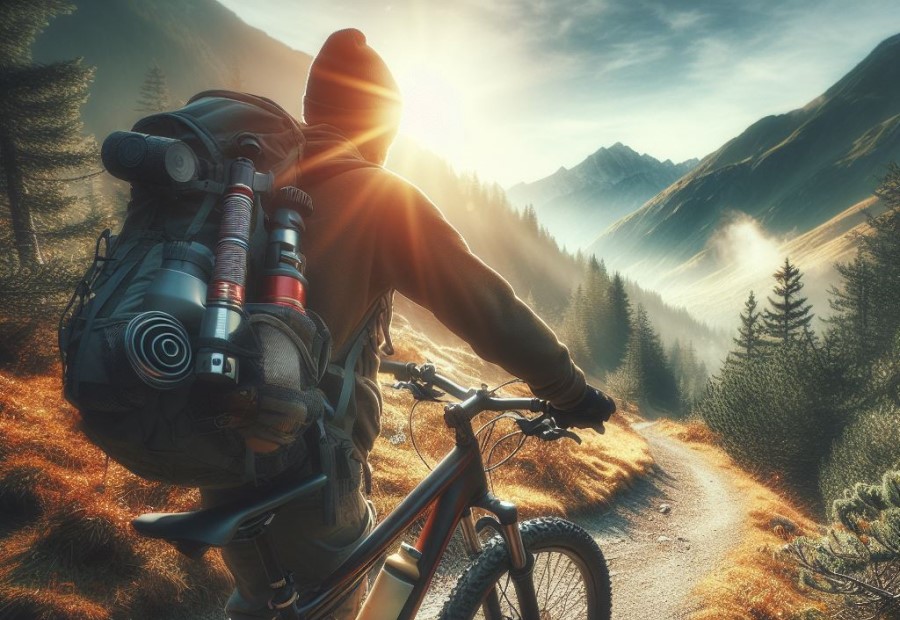
Are you ready to embark on an epic biking adventure in the wilderness? Well, the first step is choosing the perfect destination.
In this section, we’ll dig into the nitty-gritty of picking a wilderness biking spot that ticks all your boxes. We’ll talk about researching potential locations, evaluating terrain and difficulty levels, and considering seasonal factors.
Get ready to saddle up and explore the awe-inspiring beauty of nature on your two wheels!
Researching Potential Locations
When planning your biking adventure in the wilderness, researching potential locations is crucial for a successful trip. Here are some steps to consider:
- Identify your desired terrain: Determine whether you prefer mountainous, forested, or coastal landscapes for your biking adventure. This will help narrow down your options.
- Researching potential locations online: Utilize search engines, outdoor forums, and websites dedicated to wilderness biking to gather information about different locations. Look for user reviews, recommendations, and trail maps.
- Consult guidebooks: Purchase or borrow guidebooks specific to wilderness biking to get detailed insights on various locations. These books often provide information on trail difficulty, notable features, and nearby amenities.
- Speak to local experts: Reach out to local biking clubs or outdoor adventure organizations in the area you’re interested in. They can provide insider tips, trail recommendations, and information about current trail conditions.
- Consider logistical factors: Evaluate the distance and accessibility of the location from your starting point. Check if there are accommodation options, campsites, or parking facilities available nearby.
- Take safety into account: Research potential risks or hazards associated with each location, such as extreme weather conditions, wildlife encounters, or challenging terrain. Ensure you are adequately prepared for these risks.
By thoroughly researching potential locations, you can find the perfect wilderness biking destination that suits your preferences and ensures an enjoyable and safe adventure.
Evaluating Terrain and Difficulty Levels
When planning a biking adventure in the wilderness, it’s crucial to evaluate the terrain and difficulty levels of potential biking locations. By considering these factors, you can guarantee a safe and pleasant experience.
- Terrain: Before embarking on your biking adventure, take the time to assess the various types of terrain you’ll encounter. Will it mostly be flat, hilly, or mountainous? Understanding the terrain will enable you to prepare physically and mentally, as well as choose the appropriate gear.
- Difficulty Levels: It’s essential to research the difficulty levels of biking trails or routes in the wilderness. Different trails may range from beginner-friendly to advanced. By determining your skill level, you can select a route that aligns with your abilities, avoiding unnecessary challenges or risks.
- Trail Conditions: Additionally, it’s crucial to take into account the existing conditions of the trails. Are they well-maintained, or are they rough and rugged? Consider factors such as steepness, obstacles, and technical features. This information will help you gauge the level of skill and experience required.
- Elevation Gain: Another important aspect is to examine the elevation gain of the biking trails. Steeper inclines may demand more endurance and strength, while flatter routes may be more suitable for beginners or those seeking a leisurely ride.
Considering Seasonal Factors
- When planning to go biking in the wilderness, it is essential to consider the seasonal factors, including weather conditions. Research the average temperatures, precipitation levels, and any extreme weather events that may occur during that time.
- Seasonal changes can bring varying terrain conditions to the wilderness. For example, winter may bring snow or ice, spring may bring muddy trails, and summer may bring dry and dusty paths. Assessing how these changes in terrain may affect your biking experience is crucial.
- The availability of resources in the wilderness can be impacted by seasonal factors. For instance, certain water sources may be frozen or inaccessible during winter. It is important to plan for alternative water supply to ensure you have enough resources.
- Visibility and daylight hours can vary depending on the season. Winter days are shorter, while summer days are longer. It is important to consider how limited daylight hours or reduced visibility due to fog or storms in certain seasons may affect your biking adventure.
Fact: Taking into account the seasonal factors is crucial as it can significantly impact a biking adventure in the wilderness. Careful consideration of these factors will help ensure a safe and enjoyable experience.
Preparing for Your Biking Adventure
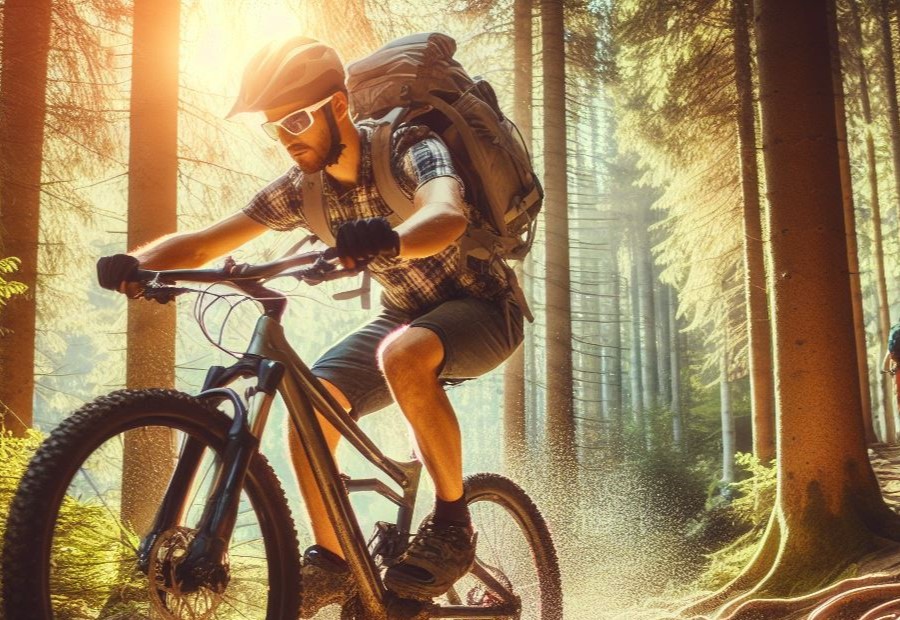
Assessing Your Fitness Level
Assessing your fitness level is crucial before embarking on a biking adventure in the wilderness. Here are some steps to help you determine your fitness level:
- Evaluate cardiovascular endurance by going for a brisk walk, jog, or bike ride for at least 30 minutes. Take note of your heart rate and how easily you can maintain a conversation.
- Assess your strength by performing basic exercises like push-ups, squats, and planks. Note the number of repetitions and your comfort level.
- Check your flexibility by doing stretches and observing your range of motion. Consider areas that feel tight or limited.
- Measure your balance and coordination by practicing balancing on one leg or navigating narrow paths.
Based on your assessment, you can determine your fitness level and make necessary adjustments to prepare for your biking adventure:
- If you have low fitness levels, gradually increase your physical activity and incorporate exercises that target cardiovascular endurance, strength, flexibility, and balance.
- Consult with a fitness professional or trainer to create a personalized fitness plan that suits your goals and abilities.
- Consider taking a cycling course to improve your biking skills and build endurance.
- Listen to your body and make modifications to your training routine if needed. Rest and recovery are important for preventing injuries and enhancing performance.
By assessing your fitness level and taking appropriate steps to improve it, you can ensure a safe and enjoyable wilderness biking adventure.
Acquiring the Right Gear and Equipment
When planning a biking adventure in the wilderness, acquiring the right gear and equipment is essential for a successful and enjoyable experience.
- Bike: Choose a sturdy and reliable bike that is suitable for off-road terrain. Consider the type of biking you will be doing, such as mountain biking or gravel biking, and select a bike that matches your chosen terrain.
- Helmet: Always prioritize safety by wearing a properly fitting helmet that meets safety standards. Protecting your head is crucial in case of any falls or accidents.
- Apparel: Dress appropriately for the weather conditions and choose moisture-wicking and breathable clothing. Opt for padded cycling shorts for added comfort on long rides.
- Footwear: Invest in a good pair of cycling shoes with proper grip and support. Clipless pedals and compatible shoes can enhance your biking efficiency.
- Tools and Repair Kit: Acquiring the right gear and equipment includes carrying a basic tool kit that includes a tire pump, spare inner tubes, tire levers, and a multi-tool for adjustments and repairs on the go.
- Navigation: Acquiring the right gear and equipment involves using a GPS device or a bike-specific map to navigate your route. Make sure to have a secure handlebar mount or a wearable navigation device.
- First Aid Kit: Pack a compact first aid kit that includes essentials like bandages, antiseptic wipes, painkillers, and any personal medications as part of acquiring the right gear and equipment.
- Water and Snacks: Stay hydrated by carrying enough water for your ride. Pack energy-boosting snacks like granola bars, trail mix, or energy gels to keep you fueled during the adventure as part of acquiring the right gear and equipment.
Mapping Out Your Route
Mapping out your route is an essential step when planning a biking adventure in the wilderness. Here are the steps to follow:
- Start by researching potential biking trails and routes in your chosen wilderness destination. Look for resources such as trail maps, guidebooks, or online forums where fellow bikers share their experiences.
- Evaluate the terrain and difficulty levels of each route you consider. Take into account factors such as elevation changes, technical sections, and trail conditions.
- Consider seasonal factors that may affect your route choice. Certain trails may be inaccessible or unsafe during certain times of the year due to weather conditions or natural events like flooding or wildfires.
- Use a combination of online mapping tools and physical maps to visualize your route. Take note of key landmarks, intersections, and points of interest along the way.
- Take into account your fitness level and the duration of your biking adventure. Plan for rest stops, water sources, and opportunities to refuel.
- Consider additional factors such as camping or lodging options along your route, as well as any permits or reservations you may need to secure in advance.
- Once you have mapped out your route, share it with a trusted friend or family member so that they are aware of your plans.
Fact: Properly mapping out your route can help you minimize the risk of getting lost or encountering unexpected challenges during your biking adventure in the wilderness.
Survival Skills and Safety Tips
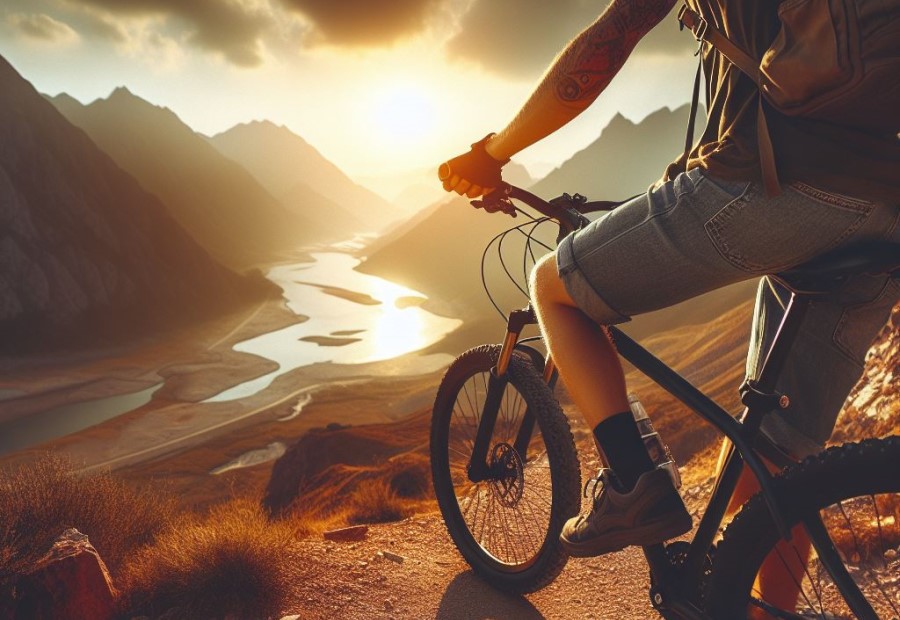
When venturing into the wild with your trusty bicycle, having the right survival skills and safety know-how is essential. In this section, we’ll explore what it takes to stay safe and prepared during your biking adventure.
From mastering basic wilderness first aid to navigating with a compass and map, and even learning how to handle wildlife encounters, we’ve got you covered. So let’s dive in and discover the skills that will keep you secure in the great outdoors.
Understanding Basic Wilderness First Aid
When embarking on a biking adventure in the wilderness, it is crucial to understand basic wilderness first aid. In this challenging and remote environment, injuries can happen, and having knowledge of how to respond can make a significant difference in the outcome.
First and foremost, understanding basic wilderness first aid involves knowing how to assess injuries. You should be able to determine the severity of wounds, fractures, or sprains. This will help you decide whether immediate medical attention is required or if you can manage the situation on your own.
Next, proper wound care is essential. You should have knowledge of how to clean and dress wounds to prevent infection. Additionally, understanding how to stop bleeding using direct pressure or a tourniquet can be lifesaving.
Basic CPR and the knowledge of how to perform rescue breathing can also be crucial in emergencies where someone’s breathing or heartbeat has stopped.
Furthermore, being familiar with common wilderness-related medical conditions, such as heatstroke, hypothermia, and dehydration, will enable you to recognize the symptoms and provide appropriate care.
Practicing communication skills is vital in wilderness first aid. Knowing how to effectively relay information to emergency services or coordinate a rescue can expedite the arrival of help.
Fact: In the wilderness, it’s estimated that it takes an average of 90 minutes for emergency services to arrive, making prompt first aid response even more crucial.
Navigating with a Compass and Map
When navigating with a compass and map during a wilderness biking adventure, it is important to follow these steps:
- First, ensure that you have a reliable compass and a detailed topographic map of the area.
- Begin by orienting the map so that it aligns with the surrounding landscape, using recognizable features or landmarks.
- Identify your current location on the map, using prominent landmarks or GPS coordinates if available.
- Determine your desired destination and plot a route on the map, taking into account terrain, distance, and any potential obstacles.
- Refer to the compass to establish a general direction of travel, aligning the compass needle with the map’s north arrow.
- As you progress along your route, regularly consult the map and compass to ensure you’re staying on track.
- Use the compass to take bearings on key landmarks or features to confirm your location and adjust your course if needed.
- Pay attention to contour lines on the map, as they indicate changes in elevation and can help you anticipate terrain challenges.
- Be aware of any magnetic declination, which is the difference between magnetic north and true north and adjust your compass readings accordingly.
- It is essential to practice using a compass and map before your biking adventure to become familiar with the process and increase your navigation skills.
Knowing How to Handle Wildlife Encounters
Knowing how to handle wildlife encounters is essential when planning a biking adventure in the wilderness. Here are some important tips to keep in mind:
- Stay calm and avoid sudden movements if you come across wildlife. Do not approach or try to touch them.
- Give animals space and observe them from a safe distance. Use binoculars or a zoom lens to get a closer look.
- If you encounter a predator such as a bear or a mountain lion, make yourself appear larger by raising your arms and standing tall.
- Make noise to alert animals of your presence. Clap your hands or speak in a loud, firm voice to avoid surprising them.
- Keep food and any scented items securely stored to avoid attracting wildlife to your campsite.
Remember, wildlife encounters can be unpredictable, so it’s important to be prepared and knowledgeable about the wildlife in the area you are visiting. Enjoy the beauty of nature while respecting the natural habitat of the animals you encounter.
Packing Essentials for a Wilderness Biking Trip
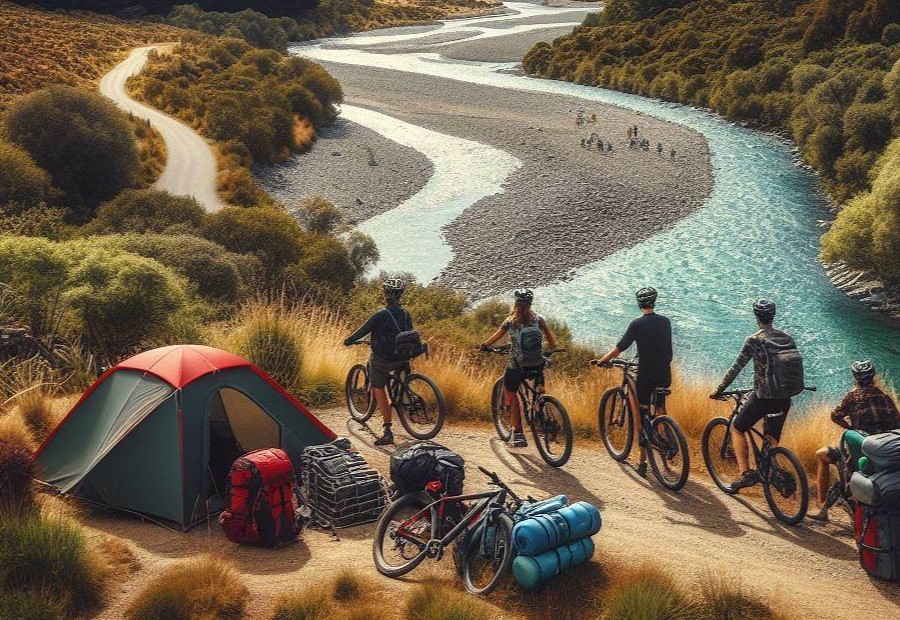
When embarking on a thrilling biking adventure in the wilderness, it’s crucial to have all the right essentials packed. In this section, we’ll cover the must-haves for your wilderness biking trip, including clothing and protective gear to keep you safe and comfortable.
We’ll also dive into the importance of proper food, water, and hydration to keep your energy levels up throughout the journey. Lastly, we’ll discuss the essential camping and sleeping equipment for a restful and rejuvenating night under the stars.
Get ready to gear up for an unforgettable wilderness biking experience!
Clothing and Protective Gear
When embarking on a biking adventure in the wilderness, it is crucial to have the appropriate clothing and protective gear to ensure your safety and comfort. Here are some essentials to consider:
- Invest in high-quality clothing and protective gear that fits properly to protect your head in case of falls or accidents.
- Wear sunglasses or goggles to shield your eyes from dust, debris, and harsh sunlight.
- Opt for clothing made from lightweight and breathable materials such as polyester or merino wool to keep you dry and comfortable.
- Choose gloves that provide grip, padding, and protection for your hands, especially during bumpy rides.
- Wear closed-toe shoes with a good grip to pedal effectively and protect your feet from rocks or branches.
- Consider wearing arm and leg warmers or guards to shield your limbs from scratches and protect against sunburn.
- Pack a waterproof jacket and pants to keep you dry during unexpected rain showers.
- Carry a compact first aid kit with essentials like band-aids, antiseptic, and pain relievers in case of minor injuries.
- Wear reflective clothing or attach reflective strips to your bike and gear to enhance visibility, especially when biking during low-light conditions.
Having the right clothing and protective gear can significantly enhance your biking experience in the wilderness, ensuring your safety and comfort throughout your adventure.
Food, Water, and Hydration
When embarking on a biking adventure in the wilderness, it is essential to prioritize food, water, and hydration to sustain yourself throughout the journey. Here are key considerations for this aspect of your trip:
Food: Pack lightweight, high-energy snacks that are easy to consume while biking, such as granola bars, trail mix, or energy gels. Aim for a balanced mix of carbohydrates, protein, and healthy fats to fuel your body.
Water: Stay well-hydrated by carrying an adequate supply of water. Depending on the duration and intensity of your biking adventure, aim to drink at least 0.5 to 1 liter of water per hour. Consider using a hydration pack or water bottles that are easily accessible while riding.
Hydration: In addition to water, consider electrolyte-enhanced drinks or powders to replenish electrolytes lost through sweat. These can help maintain your body’s fluid balance and prevent dehydration.
Nutrition: Plan meals that are easy to prepare and provide necessary nutrients. Options like dehydrated meals, instant oatmeal, or lightweight canned goods can be convenient choices. Include a mix of carbohydrates, protein, and vegetables to support your energy levels and recovery.
Camping and Sleeping Equipment
When planning a biking adventure in the wilderness, it is important to ensure that you have the right camping and sleeping equipment to make your trip comfortable and safe.
- Tent: Choose a lightweight and durable tent that is suitable for the terrain and weather conditions of your chosen destination.
- Sleeping bag: Invest in a quality sleeping bag that is appropriate for the temperatures you expect to encounter. Look for one that is lightweight and compact for easy transport.
- Sleeping pad or mattress: A sleeping pad or mattress provides insulation and a comfortable surface to sleep on. Choose one that is lightweight, easy to inflate and pack, and provides adequate cushioning.
- Pillow: While a pillow may seem like a luxury, it can greatly enhance your comfort during sleep. Look for a lightweight and compact inflatable pillow or consider using a compressible pillow.
- Camping stove: If you plan on cooking your own meals, a camping stove is essential. Choose a lightweight and portable stove that suits your cooking needs and fuel preferences.
- Cookware and utensils: Pack lightweight, non-stick cookware and utensils for preparing and eating meals. Opt for a set that includes pots, pans, plates, bowls, and utensils to cover your cooking needs.
- Headlamp or flashlight: A reliable light source is crucial for navigating your campsite at night. Choose a headlamp or flashlight with a long battery life and adjustable brightness.
- Water filtration or purification system: Ensure access to clean drinking water by bringing a water filtration or purification system. This will allow you to safely drink from natural water sources in the wilderness.
- First aid kit: Always carry a well-stocked first aid kit that includes essentials such as bandages, antiseptic ointment, pain relievers, and any necessary personal medications.
- Camp chair or stool: While not essential, a lightweight and portable camp chair or stool can provide a comfortable place to rest and relax around the campsite.
By being prepared with the right camping and sleeping equipment, you can ensure a safe and enjoyable biking adventure in the wilderness.
Planning for Emergencies
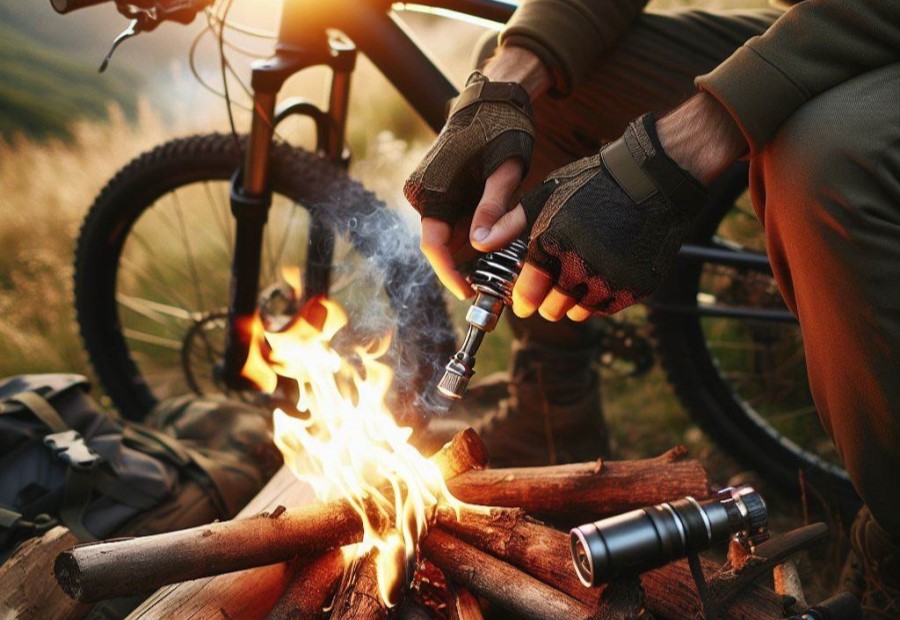
When embarking on a biking adventure in the wilderness, it’s crucial to be prepared for the unexpected. In this section, we’ll proactively tackle potential emergencies to ensure a safe and successful journey.
From creating a communication plan to handling bike breakdowns or injuries, we’ll equip you with the knowledge and strategies needed to handle any unexpected situations that may arise in the great outdoors.
So let’s dive in and get ready to conquer the wilderness with confidence!
Creating a Communication Plan
When preparing for a biking adventure in the wilderness, it is essential to develop a communication plan to ensure your safety and the ability to reach out for help if needed. Here are some important steps to consider:
- Choose an emergency contact: Select a dependable person who can be reached in case of an emergency. Share your itinerary, including your planned route and estimated time of return.
- Carry a reliable communication device: Invest in a trustworthy communication device such as a satellite phone or a personal locator beacon (PLB). These devices can be a lifesaver in remote areas where cell phone signals may be weak or unavailable.
- Learn how to operate the communication device: Familiarize yourself with the functioning of the communication device before your trip. Ensure that it is fully charged and in good working condition.
- Establish communication checkpoints: Set specific times to communicate with your emergency contact. This can be done daily or at regular intervals to provide updates on your progress and well-being.
- Familiarize yourself with emergency SOS signals: Understand the emergency signals for your chosen communication device. These signals can be used to indicate a serious emergency or an immediate need for assistance.
Emergency Shelter and Fire Starting
When planning for emergencies during your wilderness biking adventure, it is crucial to be prepared with emergency shelter and knowledge of fire-starting techniques.
- Pack a lightweight, durable emergency shelter such as a tent, bivy sack, or emergency blanket. These shelters provide protection from the elements and help retain body heat in case of unexpected weather changes or injuries.
- Carry multiple fire-starting tools, such as waterproof matches, lighters, and fire starters. These items are essential for keeping warm, cooking food, and signaling for help. Practice using these tools before embarking on your trip to ensure you can start a fire quickly and safely.
- Gather dry tinder and kindling beforehand, such as dry leaves, twigs, and small sticks. These materials ignite easily and help build a sustainable fire. Keep them in separate waterproof containers to ensure they stay dry during your journey.
- Choose a safe location for your fire pit, away from flammable materials and with proper ventilation. Clear the area around the fire pit of any debris to prevent accidental fires.
- Always practice fire safety. Never leave a fire unattended and ensure it is completely extinguished before leaving. Keep a bucket of water nearby to put out the flames or control the fire’s intensity.
- Follow Leave No Trace principles when building a fire. Use existing fire rings if available and, if not, build a fire on a fire-resistant surface like rocks or sand. Avoid damaging vegetation or natural structures.
Remember, emergency shelter and fire-starting skills are vital in ensuring your safety and well-being during your wilderness biking adventure. Stay prepared and practice responsible fire management to minimize your impact on the environment. Stay safe and enjoy your biking experience!
Dealing with Bike Breakdowns or Injuries
When dealing with bike breakdowns or injuries during a wilderness biking adventure, it’s important to be prepared and take the necessary steps to ensure safety and repair.
- Assess the situation: Quickly evaluate the severity of the bike breakdown or injury. Determine if it can be fixed on your own or if professional help is required.
- Safety first: If you or someone in your group is injured, prioritize providing first aid and seeking medical assistance if needed. Use the resources and knowledge you have to stabilize the bike breakdown or injury situation.
- Fixing bike breakdowns: If you encounter a mechanical issue with your bike, try to identify the problem and assess if you have the necessary tools and knowledge to fix it. Use spare parts or repair kits if available. If the bike breakdown is beyond your capabilities, consider ways to temporarily fix the problem to safely get back to civilization.
- Seek help if needed: In case of severe bike breakdowns or injuries, reaching out for help may be necessary. Utilize communication devices like phones, radios, or personal locator beacons to contact emergency services or your support network.
- Stay calm and patient: Remain composed and patient during the process. Remember that bike breakdowns and injuries can happen, and it’s essential to handle them calmly and efficiently.
Environmental Considerations and Leave No Trace Principles
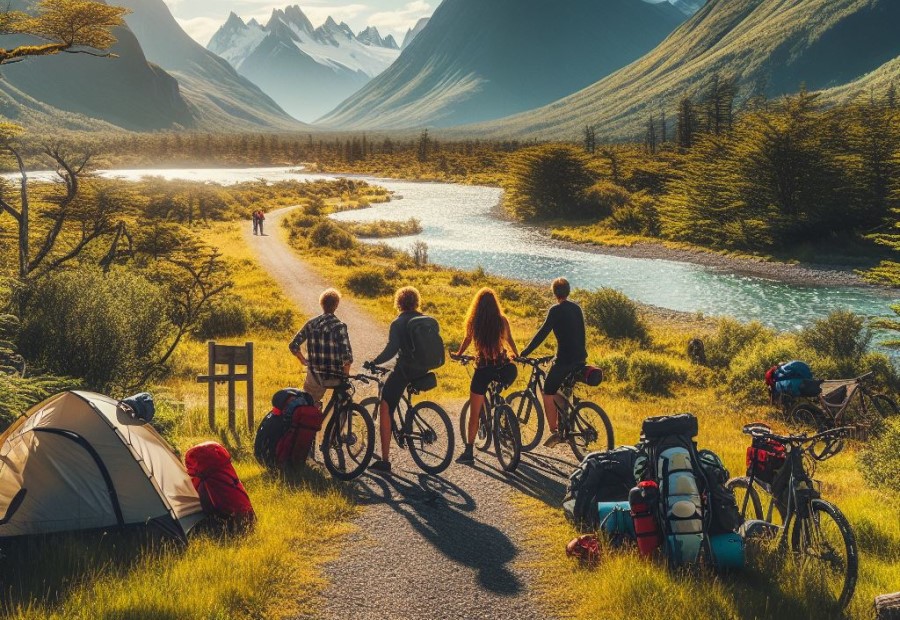
Planning a biking adventure in the wilderness? Let’s dive into the environmental considerations and Leave No Trace principles to ensure a responsible and sustainable trip.
From respecting wildlife and their habitat to minimizing our environmental impact, and even proper waste disposal and litter management, we’ll explore the essential elements of preserving the natural beauty of the wilderness while enjoying our biking expedition to the fullest.
Get ready to embark on a thrilling journey that leaves nature unharmed.
Respecting Wildlife and Their Habitat
When planning a biking adventure in the wilderness, it is crucial to respect wildlife and their habitat. You should always remember that you are a visitor in their natural environment and strive to minimize your impact:
- Avoid approaching or disturbing wildlife. Observe them from a distance, using binoculars or a camera to appreciate them without causing stress or harm.
- Stay on designated trails to avoid trampling vegetation and disturbing delicate ecosystems. Respect any closures or restrictions in place to protect wildlife habitats.
- Do not feed or interact with wild animals. Feeding can disrupt their natural feeding patterns and can make them dependent on human interaction.
- Keep your campsite clean and secure food properly to prevent attracting wildlife. Store food and scented items in bear-resistant containers or hang them from a tree away from your sleeping area.
- Dispose of waste properly by packing out all trash and litter. Leaving any traces of waste can have negative impacts on the environment and wildlife.
- Learn about the local flora and fauna before your trip so that you can appreciate and understand the ecosystems you are exploring.
By following these guidelines, you can ensure that you are actively contributing to the preservation of wildlife and their habitats during your biking adventure in the wilderness.
Minimizing Your Environmental Impact
When planning a biking adventure in the wilderness, it is crucial to minimize your environmental impact. By incorporating these guidelines, you can ensure that you leave no trace and preserve the natural beauty of the wilderness:
- Stick to designated trails to avoid damaging sensitive habitats and ecosystems.
- Stay on established roads and paths to prevent erosion and damage to vegetation.
- Pack out all your waste, including food wrappers, water bottles, and any other trash.
- Avoid using single-use plastic items such as straws, utensils, and bags. Instead, bring reusable alternatives.
- Use biodegradable or eco-friendly soaps and toiletries to minimize water pollution.
- Respect wildlife by observing them from a distance, not feeding them, and not disturbing their natural behavior.
- Keep noise levels to a minimum to minimize disturbance to wildlife and other visitors.
- Do not disturb or remove rocks, plants, or artifacts from the wilderness.
- Follow any regulations or restrictions in place for the area you are visiting, such as campfire restrictions.
By implementing these practices, you can enjoy your biking adventure while minimizing your environmental impact and leaving the wilderness untouched for future generations to enjoy.
Proper Waste Disposal and Litter Management
When embarking on a biking adventure in the wilderness, it is crucial to prioritize proper waste disposal and litter management. Proper waste disposal and litter management are essential to leave the environment as pristine as you found it, to preserve the natural beauty of the wilderness, and protect the wildlife.
Here are some guidelines to follow:
- Carry a designated trash bag or container with you to collect and store any waste generated during your trip. Proper waste disposal and litter management start with carrying a designated trash bag or container.
- Separate recyclable items such as plastic bottles or aluminum cans and dispose of them responsibly. For proper waste disposal and litter management, make sure to separate recyclable items like plastic bottles or aluminum cans and dispose of them responsibly.
- Avoid leaving any non-biodegradable materials behind, such as plastic wrappers or food packaging. Part of proper waste disposal and litter management includes avoiding leaving any non-biodegradable materials behind, such as plastic wrappers or food packaging.
- If you encounter any litter left by others, make an effort to pick it up and bring it back to civilization for proper disposal. In the spirit of proper waste disposal and litter management, whenever you encounter any litter left by others, make an effort to pick it up and bring it back to civilization for proper disposal.
- Be mindful of the waste you generate while camping and ensure it is disposed of properly in designated receptacles. Proper waste disposal and litter management require being mindful of the waste you generate while camping and ensuring it is disposed of properly in designated receptacles.
- Educate yourself on the specific waste disposal guidelines and regulations of the area you are visiting. To maintain proper waste disposal and litter management, take the time to educate yourself on the specific waste disposal guidelines and regulations of the area you are visiting.
- Practice the Leave No Trace principles, which emphasize minimizing your impact on the environment and leaving only footprints behind. Incorporating proper waste disposal and litter management is adopting the Leave No Trace principles, which emphasize minimizing your impact on the environment and leaving only footprints behind.
Remember, proper waste disposal and litter management are not just good for the environment but also for the future enjoyment of others. By taking responsibility for our waste, we can help preserve the wilderness for generations to come.
Frequently Asked Questions
Can you recommend any beginner-friendly bike tours in the wilderness?
Yes, there are several great bike tours for beginners in the wilderness. Some options include a three-day rail-trail ride along Pine Creek in Pennsylvania, a five-day tour of the Olympic Peninsula in Washington State, and a tour of the Finger Lakes region in New York.
How should I prepare for my first bike tour in terms of fitness?
It is important to train for your bike tour by riding at least four days a week leading up to it. Start with shorter rides and gradually increase your mileage. Aim for a realistic distance you can cover each day, considering factors like your fitness level, experience, and terrain.
What are some packing tips for a biking adventure in the wilderness?
When packing for a biking adventure in the wilderness, it is important to pack smart. Consider the weather conditions and pack appropriate clothing and gear. Bring your own helmet for hygiene and safety reasons. Additionally, consider essential gear such as a lightweight tent, a compact stove, bike shorts, and bike tools.
Should I choose a guided tour or plan my own biking adventure?
The choice between a guided tour or planning your own biking adventure depends on your preferences. A guided tour provides support, including hotel bookings, meals, bike repairs, and luggage transportation. If you prefer more flexibility and independence, you can plan your own adventure and choose your own routes and accommodations.
How can I transport my bike for a biking adventure in the wilderness?
There are three options for transporting your bike: renting a bike, shipping your bike, or flying with your bike. Renting a bike is easier but more expensive. Shipping your bike is a popular option, with companies like BikeFlights providing reliable services. Flying with your bike is also possible, but fees vary among airlines.
Are there any resources or catalogs available for bike tours in the wilderness?
Yes, Wilderness Voyageurs, a bike tour company, offers fully guided and supported bike tours. You can request a catalog from them to explore their different options and routes for biking adventures in the wilderness.

